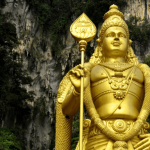What is Mahalaya Amavasya?
Mahalaya Amavasya is a new moon day dedicated to conducting special rituals for one’s deceased ‘Pitrus’ or ancestors. It is one of the important days of the Hindu tradition. The Mahalaya Amavasya is observed on the Amavasya (new moon day) of the ‘Bhadrapada’ month, based on the Amavasyant calendar followed in South India.
Rituals performed during Mahalaya Amavasya
This day is observed in honor of the ancestors, and the family members spend the day in their remembrance. On this day, people thank their ancestors who have contributed to their life. The family members seek apology from their forefathers and pray that their souls rest in peace.
Many rituals are performed during the Mahalaya Amavasya. Some of the significant rituals are listed below.
1. Tarpan and Shraddha rituals are performed for the deceased family members who passed away on the ‘Chaturdashi, ‘Amavasya, or ‘Purnima tithi.
2. During Mahalaya, the observer of rituals gets up early and completes the morning rituals.
3. The observer and his family wear yellow clothes on this day and invite a Brahmin to their house.
4. Generally, the eldest male in the family observes the shraddha ceremony.
5. He wears a ring of darbha grass. Then the ancestors are invoked to reside in the ring.
6. The observer of the shraddha ceremony performs the rituals bare-chested, as the position of the sacred thread worn by him needs to be changed multiple times during the ceremony.
6. When the Brahmin comes, the observer of the ritual washes their feet and provides them a clean place to sit.
7. According to Hindu scriptures, a specific direction for seating is followed depending on the Paksha. Deva Paksha Brahmin sits facing east, while Pitra Paksha and Matru Paksha Brahmin sit facing the northern direction.
8. Sesame seeds are sprinkled on the floor where the Brahmins are seated.
9. The Brahmin recites the mantras and invokes the ancestors of the observer’s family.
10. The ‘Pitrus’ are worshipped with dhoop, diya, and flowers. A blend of water and barley is also offered to the forefathers.
11. The shraddha ceremony involves pinda dana, an offering to the ancestors of pindas (cooked rice and barley flour balls mixed with ghee and black sesame seeds), accompanying the release of water from the hand.
12. Following this, Lord Vishnu and Yama are worshipped.
13. The food offering is then made, and it is then placed on the roof for the crow.
14. Crow is believed to be a messenger from Yama or the spirit of the ancestors.
15. The Special food is prepared for this event is offered to the Brahmins after the puja rituals are over.
16. Once the ancestors (crow) and Brahmins have eaten, the family members can begin lunch.
Significance of Mahalaya Amavasya
Mahalaya Amavasya is an auspicious occasion for Hindus. Its rituals and customs have great significance.
- The Mahalaya Amavasya rituals are performed to receive the blessings of the family ancestors.
- These rituals are aimed to bring welfare and prosperity to a family.
- The observer of this ritual receives Lord Yama’s blessings, and he and his family are safeguarded from all sorts of evils.
- As the Hindu scriptures, if a person fails to observe the shraddha of their ancestors during the first 15 days or if the death date is not known, then the ‘tarpan’ on their behalf can be observed on the day of ‘Sarvapitra Moksha Amavasya.’
- It is believed that on Mahalaya Amavasya, the forefathers and ancestors visit their home, and if their shraddha ritual is not observed on their behalf, they return unhappily.
- According to Astrology, the sins and mistakes committed by the ancestors are reflected in their children’s horoscope as ‘Pitra Dosh.’ As a result of their sins or mistakes, the souls of ancestors do not attain salvation and wander searching for peace.
- Performing the shraddha rituals to the ancestors on the Mahalaya Amavasya removes the ‘Pitru Dosh’ and will provide salvation to the wandering soul.
- As a sort of thanksgiving, the ancestors bless their family members and grant them happiness in life.
- The shraddha rituals performed on the pitra moksha Amavasya day are considered sacred and peaceful as those observed in Gaya, the holy city known for performing such rites.
Subho Mahalaya and Goddess Durga
Subho Mahalaya is an auspicious occasion observed seven days before the Durga Puja begins. It holds special significance to Bengali Hindus and marks the end of Shradh or Pitru Paksha, which is considered extremely inauspicious. On Shubho Mahalaya Amavasya, Devi paksha begins that is the time for the Goddess Durga to come to her maternal home.
The worship of the Mother Goddess is very popular in West Bengal, and hence they attach great importance to Subho Mahalaya. It is believed Mother Durga slew the demon, Mahishasur on this day. The worshippers of the Goddess invite her by chanting Chandipath and singing various bhajans in praise of her.
Pitru Paksha and Pitru Dosha
The Pitru Paksha is a 16-day lunar period in the Hindu calendar and means the “Fortnight of the Ancestors.” It is marked for performing religious rituals to the deceased ancestors. This Paksha is primarily meant for paying obeisance to the dead relatives, pleasing them by conducting rituals, asking for forgiveness, and freeing oneself of the Pitru Dosha.
During the Pitru Paksha period, auspicious functions like marriage engagement, marriage ceremonies, Grah Pravesh (house warming), and mundanam (head tonsuring ceremony of a child) are not performed.
Date and time of Mahalaya Amaavasya
This year Mahalaya Amavasya falls on October 06. The starting time and ending time of the 2021 Mahalaya and other vital details are given below for your ready reference.
Mahalaya Amavasya 2021
Sunrise October 06, 2021, 6:24 AM
Sunset October 06, 2021, 6:05 PM
Amavasya Tithi Begins —- October 05, 2021, 7:04 PM
Amavasya Tithi Ends —- October 06, 2021, 4:35 PM
Ensure to perform the Mahalaya Amavasya rituals to your deceased ancestors and free yourself from the Pitru Dosha, and experience success in your life.
« Significance and Benefits of Feeding Cow What is Brahma Muhurta & Brahmamuhurtha Time and Benefits »

